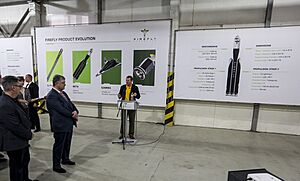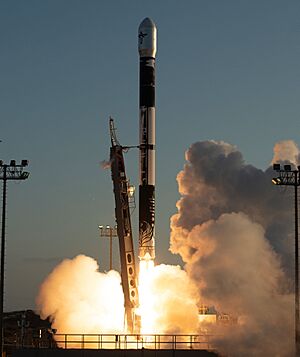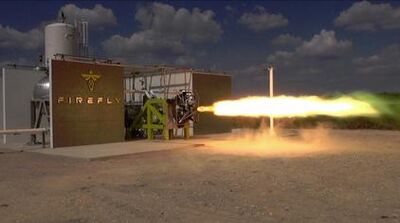Firefly Aerospace facts for kids
Firefly Aerospace, Inc. is an American company located in Cedar Park, Texas. It builds rockets that launch satellites and other things into space. They make both small and medium-sized rockets for sending items into orbit around Earth. The company you see today was formed in March 2017. It bought the parts of an older company called Firefly Space Systems and then changed its name to Firefly Aerospace. Firefly's main goal is to make it easier and more affordable for people to get to space.
Contents
History of Firefly Aerospace
How Firefly Space Systems Started
Firefly Space Systems began in January 2014. It was started by Tom Markusic and a small group of people who used their own money to get it going. In November 2014, Firefly moved its main office from California to Cedar Park, Texas. The company quickly grew to 43 employees. They also bought a large piece of land in Briggs, Texas, to test and build rocket engines.
In 2014, Firefly bought special machines to make strong, lightweight fuel tanks for rockets. These tanks were tested at a NASA center. The design for their first rocket, the Firefly Alpha, was shown in July 2014. The company hoped to be making money by 2018 by launching small satellites. They also planned to launch rockets from Florida.
Firefly tested its first rocket engine, called FRE-R1, on September 10, 2015. The first launch of the Firefly Alpha rocket was planned for 2016.
Challenges and a New Beginning
In 2016, the company faced some problems. There were legal disagreements with a former employer of Tom Markusic. These issues caused a major investor to pull out, meaning Firefly didn't have enough money to continue. The company had to stop its work in October 2016. By December 2016, Firefly Space Systems had completely stopped its engineering work.
In March 2017, a new company called EOS Launcher bought most of Firefly's assets. This new company then became Firefly Aerospace.
Firefly Aerospace Today
After the old company closed, Firefly Aerospace was restarted in March 2017 by a company called Noosphere Ventures. The owner of Noosphere Ventures, Max Polyakov, promised to pay for Firefly's first two rocket launches. The new team changed the rocket engine designs. The first launch of the new Alpha rocket was expected in 2019.
On May 17, 2018, Firefly Aerospace opened a research and development center in Dnipro, Ukraine. This center was planned to have over 150 employees. It also had Ukraine's largest 3D-printer for making metal parts.
In October 2018, Firefly Aerospace teamed up with York Space Systems. This partnership allowed them to offer customers both satellites and launch services together.
In November 2018, NASA chose Firefly Aerospace as one of nine companies that could bid for Commercial Lunar Payload Services (CLPS). This program involves sending robotic landers to the Moon. Firefly proposed a lunar lander called Firefly Genesis.
In February 2019, Firefly announced plans to build new facilities and a launch site at Cape Canaveral in Florida. They leased an old launch pad there, called Space Launch Complex 20 (SLC-20). They also have a similar agreement for a launch site on the U.S. West Coast.
In February 2021, NASA gave Firefly Aerospace about $93.3 million. This money was for developing technology for the Artemis Commercial Moon Delivery in 2023.
Firefly launched its first test flight on September 3, 2021. The Firefly Alpha rocket had a problem during its climb, and the flight was stopped for safety.
In late 2021, there were concerns from the U.S. government about Max Polyakov's ownership stake in Firefly. For national security reasons, he was asked to sell his nearly 50% share. Polyakov disagreed but agreed to sell. On February 24, 2022, it was announced that AE Industrial Partners would buy Polyakov's share.
In August 2022, Northrop Grumman announced that Firefly Aerospace would build the first stage for their new Antares 300 rocket. This new stage is similar to Firefly's own MLV rocket. It uses the same strong composite materials and seven Miranda engines. This new first stage greatly increases what the Antares rocket can carry.
On October 1, 2022, Firefly launched its Alpha rocket on its second test flight. This launch was from Vandenberg Space Force Base. The Alpha rocket completed all its goals for the mission. It became the first orbital rocket to use a special type of engine called a tap-off cycle engine. This mission was the first partly successful orbital launch for Alpha. It carried seven educational satellites, but they re-entered Earth's atmosphere about a week later because they were not deployed in the correct orbit.
On September 14, 2023, Firefly successfully launched the Alpha rocket for the United States Department of Defense. This mission put a spacecraft into orbit and showed that Firefly could launch rockets quickly when needed.
In 2024, it was announced that Firefly would compete with companies like Rocket Lab and SpaceX. They would bid for contracts to launch small satellites for the United States Department of Defense.
In August 2024, Jason Kim became the new CEO of Firefly Aerospace.
Firefly's Rockets
Firefly Alpha
The Alpha rocket is designed to be used once. It can carry about 1,030 kilograms (2,270 pounds) to low Earth orbit. It can also carry 630 kilograms (1,390 pounds) to a Sun-synchronous orbit. Firefly says the Alpha launch costs about $15 million. Alpha is made to compete with rockets like Rocket Lab's Electron.
The Alpha rocket uses four Reaver engines on its first stage and one Lightning engine on its second stage. It is built with lightweight carbon composite materials. This makes the rocket lighter and able to carry more payload.
Alpha had its first partly successful orbital launch on October 1, 2022. Its first fully successful launch happened on September 15, 2023. For this mission, Firefly launched the rocket just 27 hours after being told to launch. This set a new record for quick national security missions. The previous record was 21 days. Firefly's fourth launch on December 22, 2023, was also partly successful. The second stage did not complete its final burn, leaving its payload in an oval-shaped orbit.
Eclipse
Firefly is developing a larger rocket called the Medium Launch Vehicle (MLV), now known as Eclipse. This rocket is 4.32 meters (14.17 feet) wide. It will have seven Miranda engines on its first stage and one Vira engine on its second stage. Eclipse will be able to carry over 16,000 kilograms (35,000 pounds) to low Earth orbit.
The first Eclipse launch is planned for the second half of 2026. It will launch from Wallops Flight Facility in Virginia. Eclipse will first be used once, but Firefly plans to make its first stage reusable. This means the first stage could land back on Earth after launch. In April 2024, Firefly reported good progress on testing the Miranda engine for Eclipse. By mid-2024, the company said the MLV's first stage is being designed to return to the launch site. They hope to perfect this technology by the sixth flight of the rocket. In May 2025, Firefly and Northrop Grumman announced that MLV would be renamed Eclipse.
Antares 300
Firefly is helping Northrop Grumman build the new Antares series 300 rocket. Firefly is providing the first stage for this rocket. This first stage is a slightly less powerful version of the Eclipse first stage. The second stage of the Antares 300 is the same as the previous Antares 230+ rocket. The launch pad at Wallops is being updated to support this new, larger first stage. In April 2024, Firefly announced that testing was happening for the Antares 300.
Firefly Gamma (Concept)
Firefly Gamma was an idea for a rocket with wings. It was meant to launch small payloads into orbit. This rocket would have been partly reusable. Its first stage would land horizontally on a runway, like an airplane.
Lunar Landers
Blue Ghost
Blue Ghost is a type of lunar lander designed by Firefly. It is built to meet NASA's requirements for sending payloads to the Moon. The lander is named after a type of firefly called Phausis reticulata.
On January 15, 2025, Blue Ghost M1, Firefly's first lander, launched on a Falcon 9 Block 5 rocket. It successfully landed on the Moon on March 2, 2025. This launch also carried another lunar lander, which did not succeed.
On March 2, 2025, Blue Ghost made a perfect landing. This made Firefly the first private company in history to successfully land on the Moon.
Genesis (No Longer Used)
On June 9, 2019, Firefly Aerospace announced a plan to build a lunar lander called Genesis. This lander was based on the Beresheet lunar lander design. Genesis was proposed for NASA's CLPS program to deliver items to the Moon's surface. If chosen, Genesis would have launched in late 2022. However, NASA's requirements changed, so Firefly decided that Genesis no longer fit. They then started working on the Blue Ghost lander in 2021.
Rocket Engines
Firefly is the only company to develop a rocket engine for orbital flights using a special design called the combustion tap-off cycle. They are also the only ones to use this design with RP-1 (a type of kerosene) and liquid oxygen.
This engine design is simpler and lighter because it uses the hot, high-pressure gases from the main engine to power its pumps. This makes the engine more efficient. However, it is also harder to design and build because it needs special materials that can handle very high heat and pressure.
Other engines using this design are the Rocketdyne J-2S and Blue Origin BE-3PM. Both of these use liquid hydrogen as fuel.
Firefly designed its Reaver and Lightning engines with help from its Ukrainian branch.
Reaver
Reaver is a rocket engine designed for the first stage of Firefly's Alpha rocket. It produces 184 kilonewtons (41,000 pounds) of thrust. It uses RP-1 and liquid oxygen as fuel. The Reaver engine runs at full power from when it starts until the first stage shuts down. It is ignited using a special chemical mix.
In 2021, it was reported that Astra Space bought up to 50 modified Reaver engines. They also got the right to build their own version of the Reaver engine. Astra calls their version Chiron.
Lightning
Lightning is an engine designed for the upper stage of Firefly's Alpha rocket. It is made to work best in the vacuum of space. Lightning produces 70.1 kilonewtons (15,800 pounds) of thrust. Like Reaver, it uses RP-1 and liquid oxygen and the same tap-off cycle design. It can also be restarted in space for missions that need multiple burns.
Miranda
Miranda is a liquid-fueled rocket engine being developed for Firefly's MLV (Medium Launch Vehicle). The Miranda engine will also be used on the Antares 330 rocket for Northrop Grumman.
The Antares rocket used to have a Ukrainian-built first stage with a Russian engine. Production stopped after the Russian invasion of Ukraine. Firefly will now build the entire first stage for the Antares 330.
Like Firefly's other engines, Miranda will use RP-1 and liquid oxygen with the tap-off cycle. It is expected to produce 1,023 kilonewtons (230,000 pounds) of thrust in space.
Development of Miranda began in 2022. In 2024, Firefly reported good progress with 20 test fires completed. As of June 2024, the Miranda engine had started production. To help with production, Firefly expanded its facility in Briggs, Texas.
Firefly designed the Miranda engine to be reusable from the start. The company plans for the engine to restart multiple times as the rocket's first stage lands back at the launch site.
Vira
Vira is a version of the Miranda engine designed for the upper stage of Firefly's MLV rocket. It is made to work best in space. Like Miranda, it will use RP-1 and liquid oxygen. It is expected to produce 890 kilonewtons (200,000 pounds) of thrust in space. It can also be restarted for missions that need more than one burn.
Elytra
Firefly is developing Elytra, which are special vehicles that move payloads and satellites from one orbit to another. These vehicles can operate in low Earth orbit, higher orbits, and even near the Moon. Elytra would allow smaller rockets like Firefly's Alpha to send larger payloads to more difficult orbits. They could also help move satellites, extend their missions, or remove old satellites from orbit.
Elytra is planned to have three versions:
- Elytra Dawn: The smallest, for operations in low Earth orbit.
- Elytra Dusk: For moving things from low Earth orbit to higher orbits.
- Elytra Dark: The most powerful, for long trips to the Moon and beyond. Elytra Dark will help propel the Blue Ghost Mission 2 to lunar orbit.
Production
Firefly's main office and factory are in Cedar Park, Texas. The company has large manufacturing facilities to build parts from composite and metal materials. Firefly uses leased launch sites in California (Vandenberg Space Launch Complex 2) and Florida (SLC-20).
See also
 In Spanish: Firefly Aerospace para niños
In Spanish: Firefly Aerospace para niños
- Relativity Space
- Rocket Lab
- Stoke Space




